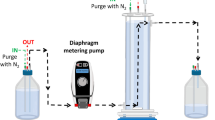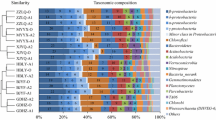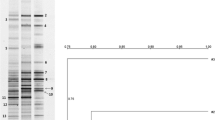Abstract
The ADNMED (Anaerobic Digestion, Nitrification, and Mixotrophic Endogenous Denitrification) system comprises a triple chamber configuration that was shown to provide high-quality effluent regarding carbon, nitrogen, and sulfide. Hydraulic retention time (HRT) was 7 h in the anaerobic and anoxic chambers, and 5 h in the aerobic chamber (stage A). Sewage was directly added to the anoxic chamber to provide extra organic electron donors for denitrification (stage B) to improve the nitrogen removal efficiency (stage A 47 ± 19%). The addition of sewage at a flow rate equivalent to 10% of the feed flow increased nitrogen removal efficiency to 61 ± 12%. Illumina® sequencing revealed a restructuring of the microbial community in the anoxic chamber, according to the availability of the endogenous electron donors for denitrification. At stage A, denitrification was related to the decay of biomass, while the addition of sewage during stage B stimulated the establishment of fermentative bacteria.




Similar content being viewed by others
References
Strous, M., Van Gerven, E., Kuenen, J. G., & Jetten, M. (1997). Effects of aerobic and microaerobic conditions on anaerobic ammonium-oxidizing (anammox) sludge. Applied and Environmental Microbiology, 63(6), 2446–2448. Retrieved from http://www.ncbi.nlm.nih.gov/pubmed/16535633.
van Kessel, M. A., Stultiens, K., Slegers, M. F., Guerrero Cruz, S., Jetten, M. S., Kartal, B., & Op den Camp, H. J. (2018). Current perspectives on the application of N-damo and anammox in wastewater treatment. Current Opinion in Biotechnology, 50, 222–227. https://doi.org/10.1016/J.COPBIO.2018.01.031.
Foresti, E., Zaiat, M., & Vallero, M. (2006). Anaerobic processes as the core technology for sustainable domestic wastewater treatment: Consolidated applications, new trends, perspectives, and challenges. Reviews in Environmental Science and Bio/Technology, 5(1), 3–19. https://doi.org/10.1007/s11157-005-4630-9.
Souza, T. S. O., Okada, D. Y., & Foresti, E. (2018). Proof of concept and improvement of a triple chamber biosystem coupling anaerobic digestion, nitrification and mixotrophic endogenous denitrification for organic matter, nitrogen and sulfide removal from domestic sewage. Bioprocess and Biosystems Engineering, 41(12), 1839–1850. https://doi.org/10.1007/s00449-018-2006-0.
Saia, F. T., Souza, T. S. O., Duarte, R. T. D., Pozzi, E., Fonseca, D., & Foresti, E. (2016). Microbial community in a pilot-scale bioreactor promoting anaerobic digestion and sulfur-driven denitrification for domestic sewage treatment. Bioprocess and Biosystems Engineering, 39(2), 341–352. https://doi.org/10.1007/s00449-015-1520-6.
Beristain-Cardoso, R., Sierra-Alvarez, R., Rowlette, P., Flores, E. R., Gomez, J., & Field, J. A. (2006). Sulfide oxidation under chemolithoautotrophic denitrifying conditions. Biotechnology and Bioengineering, 95(6), 1148–1157. https://doi.org/10.1002/bit.21084.
Tchobanoglous, G., Burton, F. L., Metcalf, E., & Stensel, H. D. (2004). Wastewater engineering: Treatment and reuse. McGraw-Hill.
APHA, AWWA, & WPCF. (2005). Standard methods for the examination of water and wastewater (21st ed.). Washington, DC: American Public Health Association.
Costa, R. B., Camiloti, P. R., Sabatini, C. A., dos Santos, C. E. D., Lima Gomes, P. C. F., & Adorno, M. Â. T. (2018). Matrix effect assessment of an ion chromatographic method to determine inorganic anions in wastewater. Water, Air, & Soil Pollution, 229(7), 212. https://doi.org/10.1007/s11270-018-3863-5.
de Faria, C. V., Delforno, T. P., Okada, D. Y., & Varesche, M. B. A. (2019). Evaluation of anionic surfactant removal by anaerobic degradation of commercial laundry wastewater and domestic sewage. Environmental Technology, 40(8), 988–996. https://doi.org/10.1080/09593330.2017.1414317.
Edgar, R. C. (2010). Search and clustering orders of magnitude faster than BLAST. Bioinformatics., 26(19), 2460–2461. https://doi.org/10.1093/bioinformatics/btq461.
Caporaso, G., Kuczynski, J., Stombaugh, J., Bittinger, K., Bushman, F., Costello, E., et al. (2010). QIIME allows analysis of high-throughput community sequencing data. Nature Methods, 7(5), 335–336 https://doi.org/10.1038/nmeth.f.303.
Wang, Q., Garrity, G. M., Tiedje, J. M., & Cole, J. R. (2007). Naïve Bayesian classifier for rapid assignment of rRNA sequences into the new bacterial taxonomy. Applied and Environmental Microbiology, 73(16), 5261–5267. https://doi.org/10.1128/aem.00062-07.
Hammer, Ø., Harper, D. A. T., & Ryan, P. D. (2001). PAST-PAlaeontological STatistics, ver. 1.89. Palaeontologia Electronica, 4(1), 1–9.
Krzywinski, M., Schein, J., Birol, İ., Connors, J., Gascoyne, R., Horsman, D., Jones, S. J., & Marra, M. A. (2009). Circos: An information aesthetic for comparative genomics. Genome Research, 19(9), 1639–1645. https://doi.org/10.1101/GR.092759.109.
Hao, T., Xiang, P., Mackey, H. R., Chi, K., Lu, H., Chui, H., van Loosdrecht, M. C. M., & Chen, G.-H. (2014). A review of biological sulfate conversions in wastewater treatment. Water Research, 65, 1–21. https://doi.org/10.1016/j.watres.2014.06.043.
Ahn, Y. H. (2006). Sustainable nitrogen elimination biotechnologies: A review. Process Biochemistry, 41(8), 1709–1721. https://doi.org/10.1016/j.procbio.2006.03.033.
Lu, H., Wu, D., Jiang, F., Ekama, G. A., van Loosdrecht, M. C. M., & Chen, G.-H. (2012). The demonstration of a novel sulfur cycle-based wastewater treatment process: Sulfate reduction, autotrophic denitrification, and nitrification integrated (SANI®) biological nitrogen removal process. Biotechnology and Bioengineering, 109(11), 2778–2789. https://doi.org/10.1002/bit.24540.
De Vos, P., Garrity, G., Jones, D., Krieg, N. R., Ludwig, W., Rainey, F. A., et al. (2009). Bergey’s manual of systematic bacteriology. In G. M. Garrity (Ed.), The Firmicutes (Vol. 3, 2nd ed.). New York: Springer.
Brenner, D. J., Krieg, N. R., & Staley, J. T. (2005). Bergey’s manual of systematic bacteriology. In G. M. Garrity (Ed.), The Proteobacteria (Vol. 2, 2nd ed.). New York: Springer.
Guo, H., Chen, C., Lee, D.-J., Wang, A., & Ren, N. (2013). Sulfur–nitrogen–carbon removal of Pseudomonas sp. C27 under sulfide stress. Enzyme and Microbial Technology, 53(1), 6–12. https://doi.org/10.1016/J.ENZMICTEC.2013.04.002.
Mergaert, J., Cnockaert, M. C., & Swings, J. (2003). Thermomonas fusca sp. nov. and Thermomonas brevis sp. nov., two mesophilic species isolated from a denitrification reactor with poly(-caprolactone) plastic granules as fixed bed, and emended description of the genus Thermomonas. International Journal of Systematic and Evolutionary Microbiology, 53(6), 1961–1966. https://doi.org/10.1099/ijs.0.02684-0.
Keller, A. H., Kleinsteuber, S., & Vogt, C. (2018). Anaerobic benzene mineralization by nitrate-reducing and sulfate-reducing microbial consortia enriched from the same site: Comparison of community composition and degradation characteristics. Microbial Ecology, 75(4), 941–953. https://doi.org/10.1007/s00248-017-1100-1.
Dolinšek, J., Lagkouvardos, I., Wanek, W., Wagner, M., & Daims, H. (2013). Interactions of nitrifying bacteria and heterotrophs: Identification of a Micavibrio-like putative predator of Nitrospira spp. Applied and Environmental Microbiology, 79(6), 2027–2037. https://doi.org/10.1128/AEM.03408-12.
Petropoulos, E., Dolfing, J., Yu, Y., Wade, M. J., Bowen, E. J., Davenport, R. J., & Curtis, T. P. (2018). Lipolysis of domestic wastewater in anaerobic reactors operating at low temperatures. Environmental Science: Water Research & Technology, 4(7), 1002–1013. https://doi.org/10.1039/C8EW00156A.
Zhou, W., Li, Y., Liu, X., He, S., & Huang, J. C. (2017). Comparison of microbial communities in different sulfur-based autotrophic denitrification reactors. Applied Microbiology and Biotechnology, 101(1), 447–453. https://doi.org/10.1007/s00253-016-7912-y.
Krieg, N. R., Staley, J. T., Brown, D. R., Hedlund, B. P., Paster, B. J., Ward, N. L., et al. (2010). Bergey’s manual of systematic bacteriology. In G. M. Garrity (Ed.), The Bacterioidetes, Spirochaetes, Tenericutes (Mollicutes), Acidobacteria, Fibrobacteres, Fusobacteria, Dictyoglomi, Gemmatimonadetes, Lentisphaerae, Verrucomicrobia, Chlamydiae, and Plantomycetes (Vol. 4, 2nd ed.). New York: Springer.
Brune, A. (2014). Symbiotic digestion of lignocellulose in termite guts. Nature Reviews Microbiology, 12(3), 168–180. https://doi.org/10.1038/nrmicro3182.
Fernandez, N., Sierra-Alvarez, R., Amils, R., Field, J. A., & Sanz, J. L. (2009). Compared microbiology of granular sludge under autotrophic, mixotrophic and heterotrophic denitrification conditions. Water Science and Technology, 59(6), 1227–1236. https://doi.org/10.2166/wst.2009.092.
Funding
The present study was funded by grant #2012/07375–7, and #2009/15984-0, São Paulo Research Foundation (FAPESP).
Author information
Authors and Affiliations
Corresponding author
Ethics declarations
Research Involving Human Participants and/or Animals
Not applicable
Informed Consent
Not applicable
Additional information
Publisher’s Note
Springer Nature remains neutral with regard to jurisdictional claims in published maps and institutional affiliations.
Electronic Supplementary Material
ESM 1
(DOCX 40 kb)
Rights and permissions
About this article
Cite this article
Okada, D.Y., Costa, R.B., Garcia, C.d.C.B. et al. Anoxic Microbial Community Robustness Under Variation of Hydraulic Retention Time and Availability of Endogenous Electron Donors. Appl Biochem Biotechnol 192, 443–454 (2020). https://doi.org/10.1007/s12010-020-03327-5
Received:
Accepted:
Published:
Issue Date:
DOI: https://doi.org/10.1007/s12010-020-03327-5




